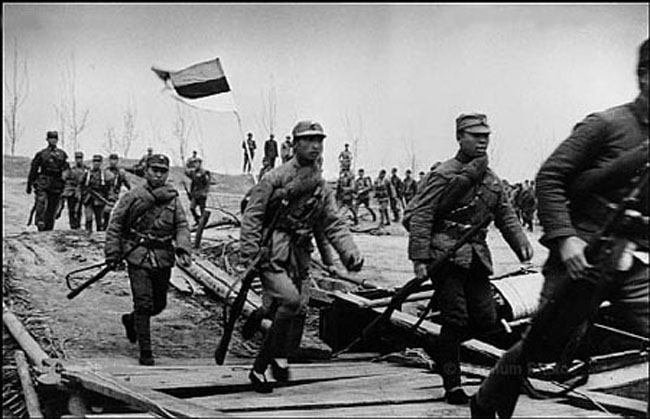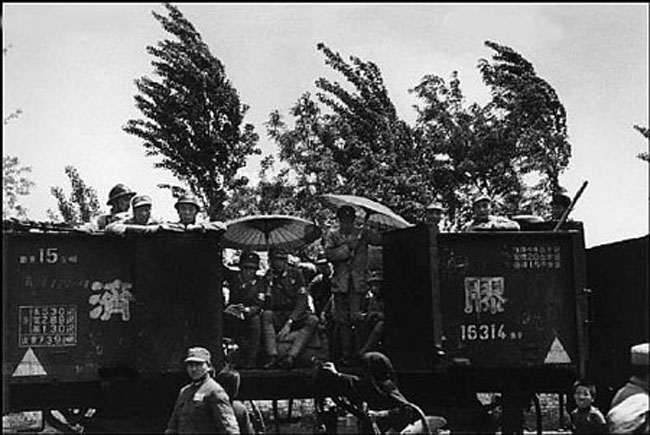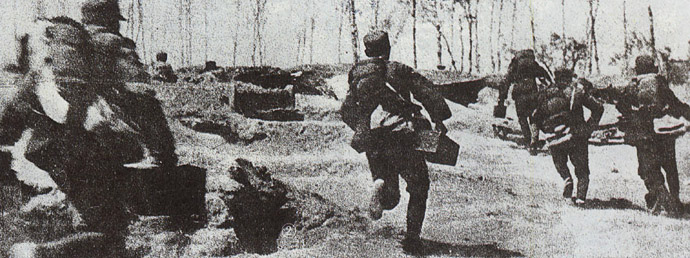Japan’s First Defeat
- By Peter Harmsen
- 7 April, 2013
- 39 Comments

Chinese troops attack at Taierzhuang
On April 7, 1938, the city of Hankou in central China “turned into a bedlam as thousands of firecrackers were exploded and newsboys tore about the streets shouting at the top of their lungs the news of the ‘annihiliation of a Japanese column at Taierzhuang’.” The scenes, described by the North China Herald, were surely not exaggerated. What had just happened was historic. It was the first defeat of the Japanese army in decades. The soldiers of the emperor, who had a history of beating both Russians and Germans, were not invincible after all.
The area around Taierzhuang, a city in north China’s Shandong province, was of obvious strategic importance. The city itself was situated on the banks of the Grand Canal, a historical waterway, mostly artificially built, that had been instrumental in transporting grain and other strategic goods from south to north for centuries. More importantly, Taierzhuang and the nearby city of Xuzhou were crucial railway hubs. In a war that was more over control of railroads than of territory, these were obvious strategic assets.

Chinese reinforcements, equipped with umbrellas, arrive at Taierzhuang
Fighting over the area picked up in late March 1938, as Japanese columns, inebriated with the victories of the past months, moved in. They may have been convinced that this would be another triumph, but the advance soon proved to be much bloodier than expected, mainly due to guerrilla-style harassment by small bands of Chinese soldiers.
Much of the fighting became focused around Taierzhuang, which the Japanese were finally able to conquer in early April. Only too late did they discover that by entering the city and taking hold of it, they had actually dug their own grave. They were surrounded by elite Chinese troops, unable to escape.
It became a blazing inferno for the Japanese invaders. Chinese troops used kerosene to set fire to buildings occupied by the Japanese, and subsequently attacked them with their feared “broad swords”. Taierzhuang, The North China Herald reported, had become “a burning hell with most of the city in flames and the Chinese and Japanese forces locked in furious hand-to-hand street fighting.”
On April 6, the Chinese commanders had amassed enough reserves to go in for the kill. In an attack that continued after dark, the Japanese defenders were completely routed and forced to retreat out of Taierzhuang. Those who failed to withdraw under the cover of night were “systematically annihilated,” official Chinese dispatches said, showing that this was a conflict where few prisoners were taken – and if so, not kept for long.
At the end of the day, the Chinese ended up losing more soldiers than their Japanese foe, but they were better equipped to absorb their losses. For the Japanese, the loss of two good divisions was a strategic disaster. A few weeks on, it was to set off a political crisis in Tokyo.

Chinese troops charge at Taierzhuang
In retrospect, the Chinese victory at Taierzhuang was due to excellent generalship and courage at all levels of command. But it was also due to a massive build-up of advanced military equipment supplied by the Russians. This had been made possible by a broadening alliance between China and the Soviet Union. Moscow, of course, had anything but altruistic reasons to help China. As long as the Chinese were able to continue the war, there was no major risk that Japan would engage in another adventure and attack the Soviet Union from the east.
The Japanese were adamant that Taierzhuang was just another in the string of victories they had scored in China since the previous summer. When asked by western war correspondents about the reports of a resounding defeat, a Japanese army spokesman had just three words: “We say—No!” But denials were useless. China had shown to the world that Japan could indeed be beaten.

 Copyright © 2025
Copyright © 2025
Leave a Reply